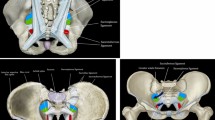Abstract
We investigated the occurrence of the post-lumbar syndrome (PPS) in relation to the puncture technique used, in a prospective randomised double-blind study comprising 100 patients. A new atraumatic 22-gauge cannula was compared with a 20-gauge cannula with a Quincke bevel. The atraumatic cannula is a needle with a tip shaped like a closed circular cone with a lateral opening, usually used with an outer cannula (introducer). The study showed that both the frequency of PPS and of acute complaints during lumbar puncture can be dramatically reduced with the atraumatic puncture technique. A marked PPS occurred after lumbar puncture with the 20-gauge cannula in 31% of patients, whereas only 5% of patients reported marked post-puncture symptoms after lumbar puncture with the atraumatic cannula.
Similar content being viewed by others
References
Adler H (1943) A study of the headaches following diagnostic spinal taps. N Y State J Med 43:1328–1330
Aguilera Celorrio L, Martínez-Garbizu I, Sáez de Equilaz Izaola JL, Arizaga Maguregui A, Sarrionaindí Azola S, Arteta Barcena M, Ortega Lago LF, Martínez Bourio Múgica R, Gutiérrez des Valle yJC (1989): Influencia del bisel de la aguja, edad y sexo en la aparición de cefalea pospunción dural. Rev Esp Anestesiol Reanim 36:16–19
Daniels AM, Sallie R (1981): Headache, lumbar puncture and expectation. Lancet 1: 1003
De Boer WA (1987) (in Dutch). Ned Tijdschr Geneesk 131:2009–2012
Diener HC, Bendig M, Hempel V (1985) Der postpunktionelle Kopfschmerz. Fortschr Neurol Psychiatr 53: 344–349
Dieterich M, Brandt T (1985) Is obligatory bed rest after lumbar puncture obsolete? Eur Arch Psychiatry Neurol Sci 235:71–75
Dietrich M, Brandt T (1988) Incidence of post-lumbar puncture headache is independent of daily fluid intake. Eur Arch Psychiatry Neurol Sci 237: 194–196
DiGiovanni AJ, Dunbar BS (1970) Epidural injections of autologous blood for postlumbar-puncture headache. Anesth Analg 49:268–271
Easton JD (1979) Headache after lumbar puncture. Lancet I: 974–975
Eicke H (1930) Die ambulante Lumbalpunktion mittels Kapillarnadel. Med Welt 12:399–401
Engelmeier M-P (1953) Über atypische Beschwerden nach der Lumbalpunktion. Med Welt 49:1579–1581
Gass H, Goldstein AS, Ruskin R, Leopold NA (1971) Chronic postmyelogram headache. Isotopic demonstration of dural leak and surgical cure. Arch Neurol 25:168–170
Gerner RH (1979) A technique to prevent headaches after diagnostic lumbar puncture. West J Med 131:160–161
Hart JR, Whitacre RJ (1951) Pencilpoint needle in prevention of postspinal headache. JAMA 147:657–658
Hilton-Jones D (1984) What is postlumbar puncture headache and is it avoidable? In: Warlow C, Garfield J (eds) Dilemmas in the management of the neurological patient. Churchil Livingston, Edinburgh, pp 144–157
Kadrie H, Driedger AA, McInnis W (1976) Persistent dural cerebrospinal fluid leak shown by retrograde radionuclide myelograhie: case report. J Nucl Med 17:797–799
Kovanen J, Sulkava R (1986) Duration of postural headache after lumbar puncture: effect of needle size. Headache 26:224–226
Kuhlendahl H (1950) Über den Auslbsungsmechanismus zentralnervöser vegetativer Reaktionen, insbesondere bei Encephalographie. Klin Wochenschr 28:544–548
Kunkle EC, Ray BS, Wolff HG (1943) Experimental studies on headache. Analysis of the headache associated with changes in intracranial pressure. Arch Neurol Psychiatry 49:323–358
Loeser EA, Hill GE, Bennett GM, Sederberg JH (1978) Time vs. success rate for epidural blood patch. Anesth 49:147–148
Low PA, Pfeifer MA (1993) Standardization of clinical tests for practise on clincal trials. In: Low PA (ed) Clinical autonomic disorders. Little, Brown, Boston, pp 287–312
McGruder JM, Cooke JE, Conroy JM, Baker JD (1988) Headache after lumbar puncture: review of the epidural blood patch. South Med J 81: 1249–1252
Rando TR, Fishman RA (1992) Spontaneous intracranial hypotension: report of two cases and review of the literature. Neurology 42:481–487
Raymond JR, Raymond PA (1988) Post-lumbar puncture headache. Etiology and management. West J Med 148:551–554
Schaltenbrand G (1938) Neuere Anschauungen zur Pathophysiologie der Liquorzirkulation. Zentralbi Neurochir 3:290–300
Schaltenbrand G (1940) Die akute Aliquorrhoe. Verh Dtsch Ges Inn Med 52:473–481
Schorr MR (1966) Needles — some points to think about. Anesth Analg 45:509–526
Sicuteri F (1966) Headache and meningismus evoked by lumbar puncture and subarachnoid hemorrhage: a biochemical interpretation. Headache 5:108–110
Sprotte G, Schedel R, Pajunk H (1987) Eine “atraumatische” Universalkanüle für einzeitige Regionalanästhesien. Reg Anesth 10:104–108
Torrey EF (1979) Headaches after lumbar puncture and insensitivity to pain in psychiatric patients. N Engl J Med 301:110
Tourtelotte WW, Haerer AF, Heller GL (1964) Post-lumbar puncture headache. Thomas, Springfield, pp 3–47
Tourtelotte WW, Henderson WG, Tucker RP, Gilland O, Walker JE, Kokman E (1972) A randomized, double-blind clincial trial comparing the 22 versus the 26 gauge needle in the production of the post-lumbar puncture syndrome in normal individuals. Headache 12:73–78
Trautmann E (1928) Über Ursachen, Wesen und Verhütung des sogenannten Meningismus nach Lumbalpunktion. Klin Wochenschr 7:695–699
Van den Hout JHW, Feldberg MAM (1988) (in Dutch). Ned Tijdschr Geneeskd 132:177
Vilming ST, Schrader H, Monstad I (1988) Post-lumbar-puncture headache: the significance of body posture. A controlled study of 300 patients. Cephalgia 8:75–78
Wiggli U, Oberson R (1975) Die Häufigkeitextra-arachnoidalen Liquorausflußes nach Lumbalpunktion. Schweiz Med Wochenschr 105:235–239
Zerssen D von (1971) Zur standardisierten isierten psychopathologischen Befunderhebung im Rahmen epidemiologischer Untersuchungen. Zentralbl Gesamte Neurol Psychiat 203:246
Author information
Authors and Affiliations
Rights and permissions
About this article
Cite this article
Müller, B., Adelt, K., Reichmann, H. et al. Atraumatic needle reduces the incidence of post-lumbar puncture syndrome. J Neurol 241, 376–380 (1994). https://doi.org/10.1007/BF02033354
Received:
Accepted:
Issue Date:
DOI: https://doi.org/10.1007/BF02033354




